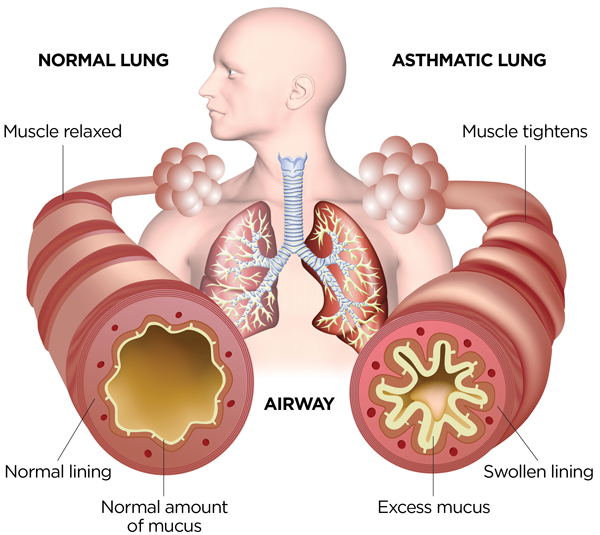Asthma
Published .

Asthma is a chronic lung disease. It affects the bronchioles (airways) which are the tubes that carry air in and out of the lungs. When the patient has asthma, their bronchioles can become inflamed and narrowed. This can cause wheezing, coughing, and tightness in the chest. When these symptoms get worse than usual, it is called an asthma attack or flare-up.
What causes asthma?
The exact cause of asthma is unknown. Genetics and the environment likely play a role in who gets asthma. An asthma attack can happen when exposed to an asthma trigger. An asthma trigger is something that can set off or worsen asthma symptoms. Different triggers can cause different types of asthma:
- Allergic asthma is caused by allergens. Allergens are substances that cause an allergic reaction. They can include
- Dust mites
- Mold
- Pets
- Pollen from grass, trees, and weeds
- Waste from pests such as cockroaches and mice
- Nonallergic asthma is caused by triggers that are not allergens, such as
- Breathing in cold air
- Certain medicines
- Household chemicals
- Infections such as colds and the flu
- Outdoor air pollution
- Tobacco smoke
- Occupational asthma is caused by breathing in chemicals or industrial dusts at work
- Exercise-induced asthma happens during physical exercise, especially when the air is dry
Asthma triggers may be different for each person and can change over time.
Who is at risk for asthma?
Asthma affects people of all ages, but it often starts during childhood. Certain factors can raise the risk of having asthma:
- Being exposed to secondhand smoke
- Being exposed to certain substances at work, such as chemical irritants or industrial dusts
- Genetics and family history.
- Race or ethnicity. Black and African Americans and Puerto Ricans are at higher risk of asthma than people of other races or ethnicities.
- Having other diseases or conditions such as obesity and allergies
- Often having viral respiratory infections as a young child
- Sex. In children, asthma is more common in boys. In teens and adults, it is more common in women.
What are the symptoms of asthma?
The symptoms of asthma include:
- Chest tightness
- Coughing, especially at night or early morning
- Shortness of breath
- Wheezing, which causes a whistling sound during exhalation
These symptoms can range from mild to severe and the patient may have them every day or only once in a while. Asthma attacks may come on gradually or suddenly. Sometimes they can be life-threatening. They are more common in people who have severe asthma.
How is asthma diagnosed?
Physicians may use many tools to diagnose asthma:
- Physical exam
- Medical history
- Lung function tests, including spirometry, to test how well the lungs work
- Tests to measure how the airways react to specific exposures. During this test, the patient will inhale different concentrations of allergens or medicines that may tighten the muscles in the airways. Spirometry is done before and after the test.
- Peak expiratory flow (PEF) tests to measure how fast the patient can blow air out using maximum effort
- Fractional exhaled nitric oxide (FeNO) tests to measure levels of nitric oxide in the exhaled breaths. High levels of nitric oxide may mean that the lungs are inflamed.
- Allergy skin or blood tests, if the patient has a history of allergies. These tests check which allergens cause a reaction from the immune system.
What are the treatments for asthma?
Asthma patients need to work with their health care provider to create a treatment plan. The plan will include ways to manage asthma symptoms and prevent asthma attacks. It will include:
- Strategies to avoid triggers. For example, if tobacco smoke is a trigger the patient should not smoke or allow other people to smoke in the home or car.
- Short-term relief medicines, also called quick-relief medicines. They help prevent symptoms or relieve symptoms during an asthma attack. They include an inhaler to carry at all the times. It may also include other types of medicines which work quickly to help open airways.
- Control medicines. Patients take them every day to help prevent symptoms. They work by reducing airway inflammation and preventing narrowing of the airways.
